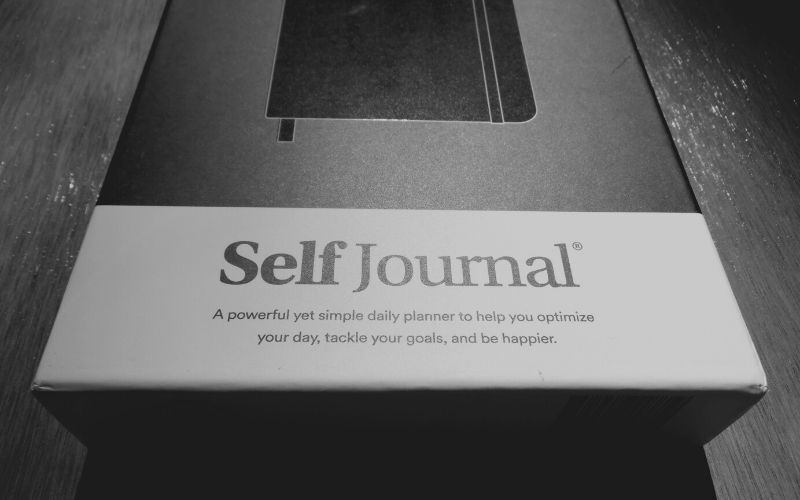
I’ve used a wide variety of different journals, planners, and goal achievement systems over the years. And recently, I’ve started using the Self Journal, from BestSelf. This is going to be our official BestSelf Self Journal review.
There were a lot of things that I liked about this particular journal—but for this review, I wanted to get a fresh perspective.
So I enlisted the help of one of my students who recently started using the Self Journal for the very first time. And so, from this point forward, the words are going to be the straight truth about his experiences using the journal for the very first time.
Together, we accumulated the data, the good points, the bad points, the pros, and the cons, and compiled them all here so that you can read it and decide for yourself if the BestSelf Self Journal might be the perfect goal-setting/achievement system for you.
As I often say—it doesn’t matter which system you use—as long as you choose a system that works for you, and you stay consistent with your plan and goals.
So what is our official opinion of the Self Journal?
Let’s dive into it and get started.

The BestSelf Self Journal is one of several goal-achievement and goal-tracking products offered by a company called BestSelf.
This company also sells a planner. But I found the Self Journal to be their most attractive introductory product for people who are wanting to take goal setting more seriously. And thus, that’s what we’ll be reviewing in this BestSelf Self Journal review.
BestSelf describes the journal as follows:
“A powerful yet simple daily planner to help you optimize your day, tackle your goals, and be happier.”
And I would agree with this basic assessment.
When you order the BestSelf Self Journal directly from the company, you’ll pay $32. They also offer fast and free shipping—but in order to qualify for it, you need to spend over $45.
If you buy 4 of the journals at a time (which is enough for the entire year), then you also get 25% off of your order.
If you know for sure that you’re going to commit to using the Self Journal for an entire year, then this is definitely the most cost-effective way to purchase it.
You can also subscribe to have a journal shipped to you every quarter. This saves you 15%, bringing the cost of each journal down to $27.20.
By comparison, you can order Michael Hyatt’s Full Focus Planner for $40.99 before shipping—and to be honest, the Self Journal bore a lot of similarities to the Full Focus Planner.
Therefore, the Self Journal gets some high marks for being a bit more cost-effective—though it’s still a bit on the ‘pricey’ side when you compare it to buying a regular calendar book from your local office department store (which you can get for about $12).
With that being said, it was pretty evident coming out of the gate that you aren’t just paying for a notebook when you buy the Self Journal.
You’re actually paying for a fully-fleshed out, well-designed, all-encompassing analog goal achievement system.
And so, in my opinion, it was worth the money. And while I do love the Full Focus Planner, I’ll admit that it felt good to save that extra $8 per quarter (though the Self Journal also doesn’t go quite as in-depth as the Full Focus Planner—but we will talk about that more in a moment).
The Self Journal comes in 4 different color options: Classic Navy, Black, Coral, and Canary. I chose the black one—and I really liked how it looked.

It took the Self Journal about a week to arrive.
It arrived in perfect condition, packaged in a protective cardboard box.
The journal itself also ships with its own snug-fitting branded cardboard box case, which looks really nice. It also comes with a few added extras in the box.
In addition to the Self Journal, you also get:
I wasn’t really expecting any of these things—so they were useful and value-packed additions.
Upon opening up the Self Journal for the first time, I was immediately impressed by the quality.
The outside cover feels soft to the touch, almost like it’s covered with a thin layer of some kind of fabric.
The overall construction quality was excellent. It felt sturdy and well-crafted in my hands.
The binding felt strong and durable, and the paper seemed to be high in quality as well.
The color was quite ‘white,’ and the fonts and inks used within the journal were pleasant to look at, easy to read, and gentle on the eyes.
I found the overall design ‘modern, minimalistic, and inspiring.’
It has a stretchable band that keeps the journal closed when it’s not in use. It also has three ribbons that you can use to save the spots you were working in.
Overall, I give the journal high marks for the quality of construction.
So now, let’s dive into the interior of the journal, and discuss the quality of the system itself.
The very first thing I noticed about this system is that it’s pretty intuitive.
It makes daily goal-setting and habit tracking relatively easy, even for beginners.
It’s a lot more in-depth (and provides more guidance) than a simple calendar book or notebook.
But it’s also not as complicated to jump into as something more advanced, like the Full Focus Planner.
After diving into the journal, learning how to use it, and experimenting with it a bit—I quickly concluded that this system would be a pretty good fit for beginners who aren’t super experienced with goal setting yet.
If you’ve never put any thought or effort into goal setting, but are trying to begin the process of starting a daily goal-setting habit in your life, then the Self Journal may be an awesome option for you.
It’s simple enough that you can dive right into it without doing a bunch of extra work. However, it also provides some added depth that you can quickly learn to make use of as you broaden your goal-setting and goal-achievement horizons.
I would classify this journal as a great option for the novice goal-setter who wants to take goal setting seriously. It’s also a great fit for more experienced goal-setters who thrive with a more basic, simpler framework for setting daily goals.
However, don’t get it twisted—the Self Journal packs-in quite a bit of goal-setting depth.
And once you get the hang of it, you’ll find that you can really go in-depth and use these tools to help you maximize your daily efforts.
Alright. Now, let’s move on to talk about the different parts of the system, and how to use it.
Now, let’s jump into the specifics of how to use the Self Journal.
In this section of our BestSelf Self Journal review, we’re going to go through all of the different parts of the system, talk about what they’re for, and give you a basic overview of how those sections are used.
You’re also going to get an inside perspective into my own personal experiences with each of these portions—to see exactly how I utilized them and whether or not I found them particularly useful.
For starters, however, BestSelf actually gives you quite a few free resources (available on YouTube and on their website) to help you jump right into the Self Journal and start strong from the beginning.
You can read their free full-length guide, titled Getting Started With Your Self Journal on their website.
But they also have a YouTube channel full of helpful content to add to this.
I combed through the content and watched the videos that I thought were most interesting based on the titles. But the best one I found was this one—which basically describes how Cathryn Lavery, the creator of the Self Journal, uses it in her own life. It really gives a unique perspective into some creative ideas for the journal, and it’s definitely worth watching:
After you’ve taken a look at those resources, it’ll be time to jump into the next section.
Let’s dive in.

Before we dive into the journal itself, let’s break down these ‘extras’ that come in the box.
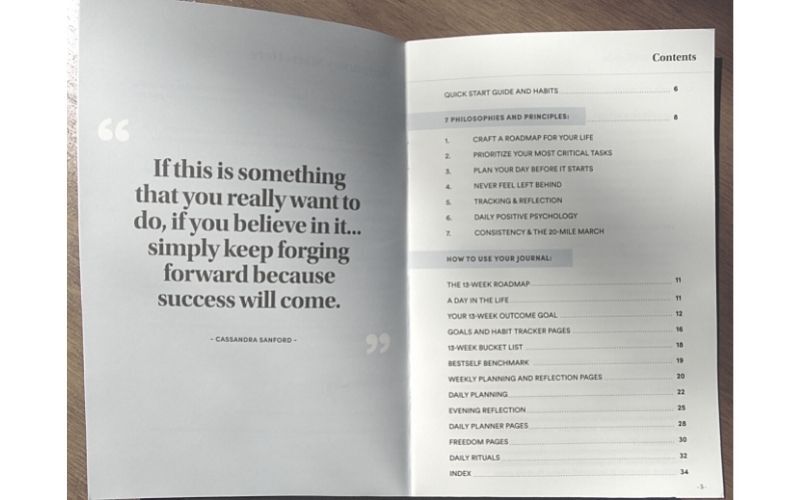
First off, the Guidebook is exactly what it sounds like—a guide for how to get started with the Self Journal.
It’s pretty simple, and I would suggest that you read it through all the way—because it really does a good job of explaining how the system works.
Secondly, we have the 13-Week RoadMap. This is basically a sheet that you can either keep folded up beside (or even inside) your planner, or that you can hang up on the wall.
You use the 13-Week RoadMap as follows.
The Self Journal basically walks you through all of the steps needed to succeed at your goals for the 13 week quarter. Not only does it empower you to set goals for the quarter, but it also empowers you to break your goals down by the week—and then, by the day—to help you stay on track.
So, you can use the 13-Week Roadmap to basically keep up a streak of days where you keep up with all of the important habits and tasks that must get done on a daily basis.
This speaks to the built-in daily goal achievement system of the Self Journal, and how it functions to help you set longer-term goals while also helping you to stay focused on the stuff that needs to get done today.
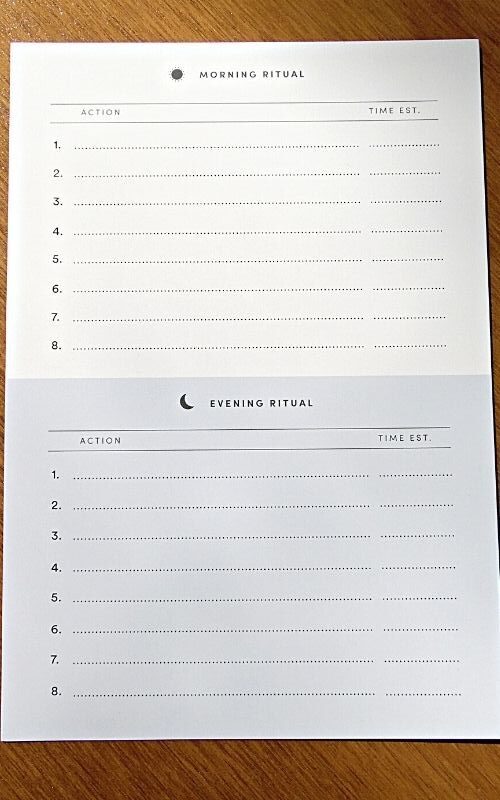
And thirdly, we have the Daily Rituals Card. Your Self Journal will come with one of these, and it’s actually super useful.
Its purpose is pretty simple.
You use it to write out and organize your morning and evening rituals. Then, you’re supposed to set the card somewhere where it’ll remind you of these rituals every morning and night.
Personally, I’m really big on daily rituals to help me be more successful. So this was an unexpected (but very useful) element to the system that I really appreciated!
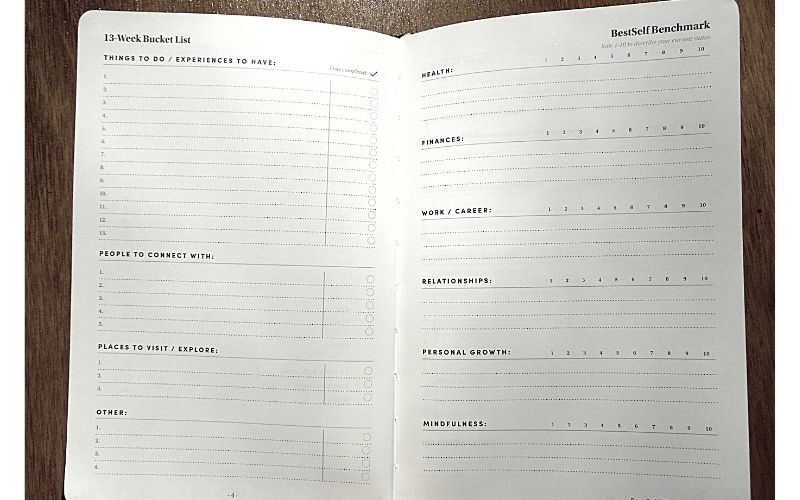
Now, it’s time to delve into the Self Journal, and talk about the very first section you’ll find when you open it up.
The 13-Week Bucket List.
This section is pretty much exactly what it sounds like—a dedicated section where you can record your major bucket-list items for the next quarter, with space provided for 4 different domains to write down items in. These domains include:
The idea here is that you can write down some bucket-list items that you want to be intentional about pursuing over the next quarter.
Directly across from the 13-Week Bucket List page is a section called the BestSelf Benchmark Page. This page basically helps you to perform a sort of ‘self-assessment’ of several key areas of your life. The domains included here are:
This section is designed to help you work on your work-life balance over the course of the next 13 weeks. It gives you some space to make notes of where you are, and where you want to be. It also gives you 1 to 10 ranking numbers that you can circle to measure how satisfied you are with your current progress in that area of life at this current moment.
This is useful for determining which domains you may want to work on as you set goals for the next 13 weeks.
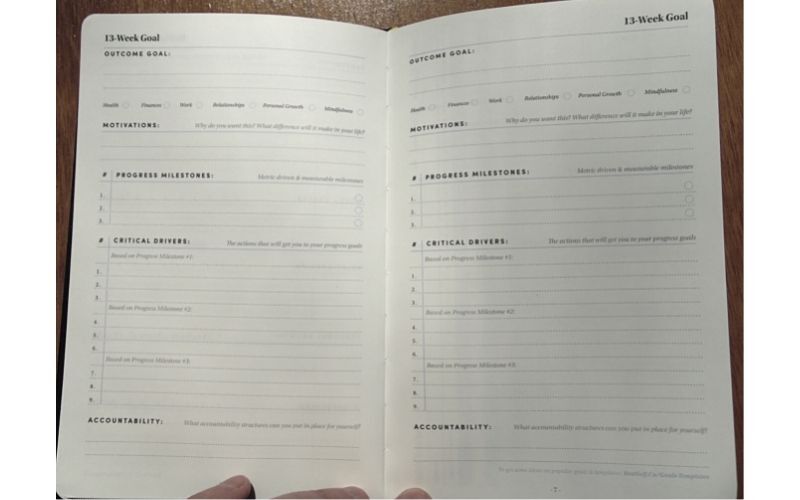
Next, we come to the 13-Week Goal pages.
This is where the Self Journal really starts taking you through the beginnings of its core system.
There are 3 of these pages, which means that you have room to fill out information about your 3 biggest overarching goals for the quarter.
This number was chosen intentionally by BestSelf, it would seem, to give you enough goal-setting space to challenge you without allowing you to overwhelm yourself.
They really focus on the ‘big 3’ kind of mentality with these goals, not so unlike you see with the Full Focus Planner. And you’ll see that this theme of ‘3 most important goals’ is consistently repeated throughout the Self Journal system.
Anyway—this space lets you track a lot of information related to each 13-week goal, including:
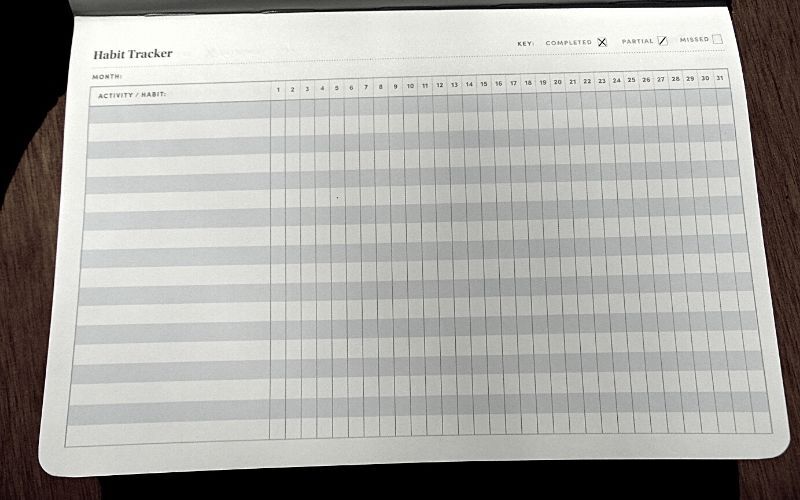
The habit tracker pages basically give you space to record habits that you want to start taking more seriously, and then provides you with a space where you can check them off by the day as you complete them.
This helps you to build a ‘streak,’ which is another recurring theme in the Self Journal system.
The idea is this:
If you get a streak built up, you’ll gain momentum and be less willing to just let a day go by where you don’t perform those productive habits. Therefore, you’ll be more likely to stick to those habits, so that you don’t ‘lose your streak.’
I love it!
I’m all about good habits. So I was happy to see this included in the journal.
There are 3 of these pages—with enough space to record up to 17 positive habits every month, with 31 ‘streak days’ in every month to mark them as completed.
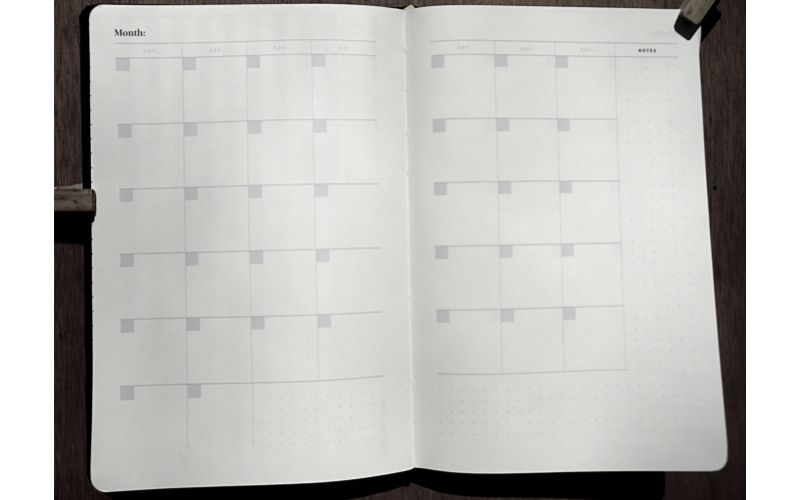
These are basically calendar pages that give you the power to write-in the month and date yourself.
You can use them for anything you want. Personally, I found these useful for keeping track of larger goal points spaced throughout the 13 weeks.
For example, I had a weight loss/fitness goal that was going to take me a month—and these pages were a perfect reference point where I could write down that goal and then look at that date with a bird’s eye view.
There are 3-months worth of calendar pages, enough to take you through the 13 week quarter.
I also love how they’re not pre-dated. By leaving all of the dates open for you to fill in yourself, BestSelf is basically giving you the power to begin the process whenever you want.
Also, this makes it so that your journal will never just ‘age out’ due to pre-printed dates.
So, I really appreciated that feature in this section.
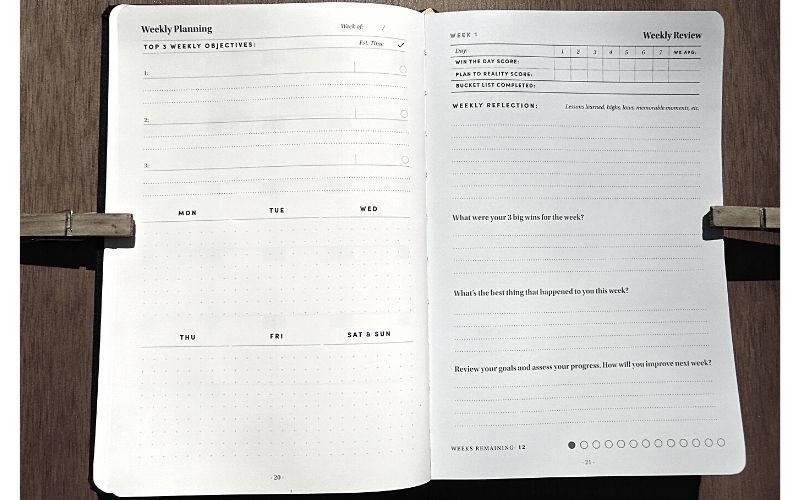
The Weekly Planning Pages are basically the pages where you plan out the 13 weeks of the quarter—and the Weekly Review Pages are where you review those weeks.
These sections give you several tools that will empower you to plan out your week in a detailed, orderly fashion—and they also give you some strategic prompts for helping you to look back on your week after it’s complete, empowering you to evaluate your performance and results.
You’re supposed to fill these sections out on a weekly basis. The great thing about these pages is that they really help you to tie your long-term goals together with your daily goals, and further allow you to break down each week to focus on the things that matter most.
Each of these sections contains the following:
I really liked this section.
The fact that it continued on with the theme of the ‘top 3 weekly objectives’ was really useful to me, because this gives you room to prioritize while also helping to keep you from overwhelming yourself.
When you’re limited to 3 main priorities, it really makes you think about what’s important.
And that speaks to the power of living intentionally.
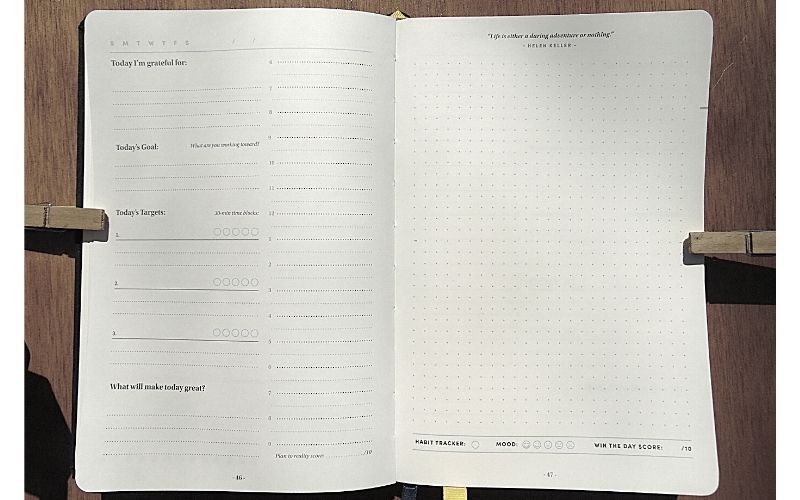
These pages make up the majority of the pages contained within the Self Journal.
They’re designed for daily use, and there are enough of them to carry you through the entire 13 week period.
On the daily planning pages, the first thing you’ll do each day is answer the question “what I’m grateful for.”
The BestSelf system works based on several scientific principles—and gratitude is one of them.
Here’s an excerpt from the Self Journal Guidebook that really encapsulates this:
“Studies indicate that beginning your day with gratitude can rewrite your brain to have a more positive outlook on life. Gratitude means counting your blessings, appreciating the simple pleasures, and appreciating everything you have. By practicing a daily habit of gratitude, you’ll begin to see and think differently, especially during moments when you feel stuck in a rut.”
The daily planning pages also contain spaces where you can write:
On the opposite page, there’s a ‘free page,’ which is basically a notebook page covered with small dots that form a light grid pattern.
You can use this page to take freeform notes, to make doodles, to draw pictures, or to do anything else you might want to do.
There are a lot of small technical details on this page as well—like a habit tracker dot, a mood indicator, a win the day score tracker, etc.
You can learn about the specifics of these things by watching the how-to videos and reading through the Guidebook.
But all things considered, the pages do a great job of providing you with a fairly minimalistic, open-ended framework for setting, accomplishing, and then checking-off your daily goals.
I really liked how BestSelf laid these pages out.
(Note: At the end of the journal, there are some more of those free pages as well, that you can use for overflow or to take notes about other things. These pages are a nice addition. They don’t give you a ton of note-taking space to work with—but if you need to take notes in a pinch, and don’t want to use up the free pages in the daily planning sections, these are super useful and a big value add.)
There’s also one ‘notes’ page at the very back of the journal.
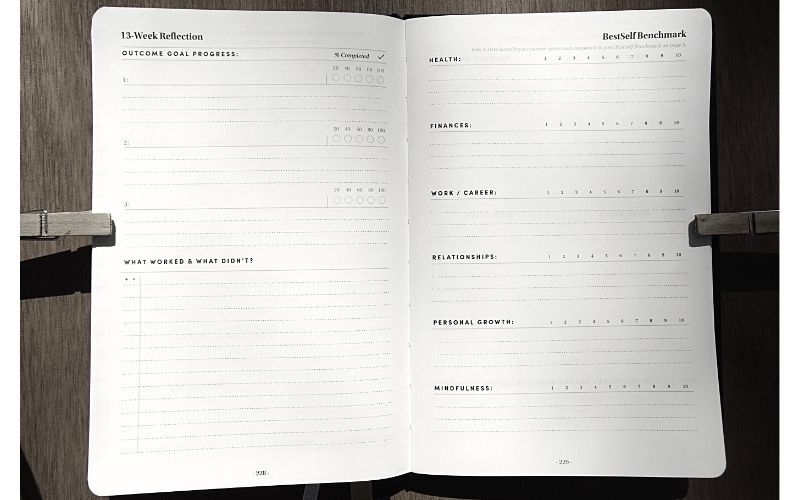
Toward the end of the journal, after you’ve gotten through all of the Daily Planning Pages, you’ll find a section that gives you the chance to reflect back on the last 13 weeks, to take stock of your progress and to begin planning for the next quarter.
You’ll only complete this section once you fill out all 13-weeks’ worth of Daily Planning Pages, and reach the end of the quarter.
This section asks you to rate your progress on all 3 of your major quarterly goals. It also asks you to rate how you felt about the last 13 weeks in the following domains:
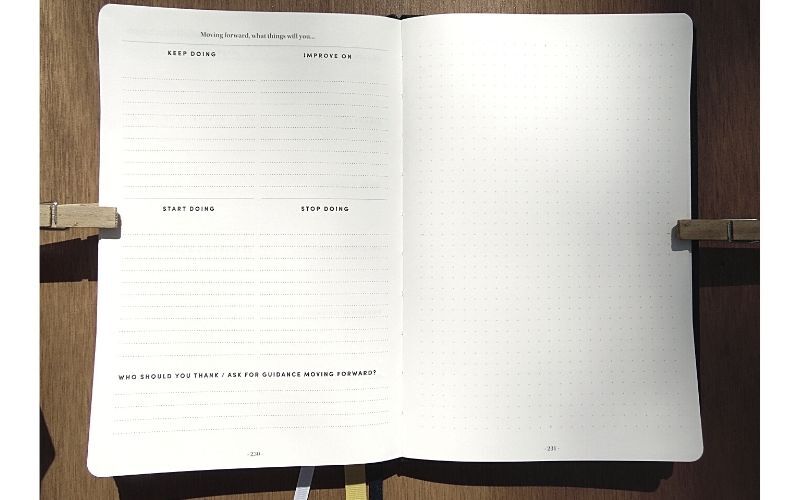
You’ll notice that this section basically mirrors some of the information you filled out when you first started the journal.
It also provides prompts and spaces for you to fill out to help you move into the next quarter with an even better opportunity for success—empowering you to learn from your mistakes, celebrate your victories, and just reflect on how to make your next 13 weeks even better than the previous quarter was.
There were a lot of things about this planner that I liked. But in order to bring all of these thoughts to cohesive points, I’m just going to share my top 7 favorite things about it with you.
It looks beautiful, feels sturdy, and definitely performs like a quality piece of gear.
It gives you the power to brainstorm some bigger, more open-ended dreams for the year—and the fact that the journal gives you a place to record these dreams is pretty cool. I liked the open-endedness of it.
While this journal is still a lot more expensive than a regular notebook or blank journal from any local retail store, I felt like the value-additions of the contents and the system really made it worth the price.
I feel like even a goal-setting newbie could pick up the Self Journal and get started with a daily goal setting on the right foot. It’s just pretty intuitive and simple to use.
I personally like this approach to weekly planning, and found these pages useful and uncluttered.
I also like how the BestSelf system makes use of ‘streaks’ to keep you motivated. This really aligns with my own personal goal-setting and motivation style, so I found this to be extremely effective.
Once again, they were minimalist, uncluttered, and simple. They leave a lot of room for creativity. I was a fan of this. It kind of just leaves you alone to set your goals the way you want, while also utilizing the gentle ‘guidance’ of the system to help keep you focused.
So, I felt like this was a good balance.
The price point, while lower than the price point for other systems, was still a bit on the high side.
It’s almost the equivalent of buying a new hardcover book from the bookstore every 13 weeks, and the fact that you need to replace it every quarter might be a deterrent to some.
Personally, I found it to be well worth the price. But, the price point could be an issue for people who are really trying to pinch pennies and not spend extra money.
Another thing that I noticed about this system that I wasn’t the biggest fan of was the fact that it really only gives you space to write down 4 main tasks in the Daily Planning Pages.
If you want to include any other tasks, they’ll either need to be written in the free pages or the time-slot section.
Now, this really isn’t too big of a criticism. The main reason for why I say this is because I’m just used to writing down my tasks differently from the style utilized by Self Journal—so it’s kind of a habit thing for me.
Even so, I can easily utilize the free pages opposite the Daily Planning Pages to make this slight quirk work for me.
Aside from that, I don’t find myself wishing that the journal did things any differently. It is different from the goal-setting style I usually utilize—but I can also see how powerful the simplicity of this system could be when utilized correctly.
Here are the biggest pros and cons of the Self Journal
If you’re ready to dive into a complete goal-achievement system, and want something more in-depth than a blank sheet of paper or a notebook for writing down your short, medium, and long-term goals that also won’t overwhelm you or confuse you—then the Self Journal may be an awesome option for you.
This is a fantastic system for people who want to jump right into goal setting without needing to navigate a steep learning curve or spend a bunch of time during the week meticulously plotting out their goals.
It’s truly an awesome analog planner for goal-setters of all ages and skill levels—and works especially well for beginners.
If you’ve already dipped your toes into more complicated systems (like the Full Focus Planner), and/or if it’s important to you to utilize a system that contains elements to facilitate a longer-term timeline than the next 13 weeks, then this system may leave you wishing for more.
It’s also really simplistic.
For some people, this is awesome.
But for people who want to spend a bit more time meticulously crafting goals and getting really in-depth with their quarterly, weekly, and daily plans—then the Self Journal may simply not offer the kind of in-depth mechanisms to support those types of goal-achievement styles.
My official opinion is that the Self Journal’s positive reputation in the goal-achievement space is absolutely well deserved—and I believe it to be a minimalistic analog goal-setting system that’s absolutely capable of standing on its own without being confusing or ‘too deep’ at the same time.
To put it simply—I really liked it.
I would absolutely recommend this as an entry-level system for people who are just graduating from tracking daily to-do lists in a blank notebook or calendar book—because the system gives you a lot of infrastructure for more advanced goal-setting without being overbearing.
So yeah! It’s awesome.
I give it an 8 out of 10!
It’s hard to imagine developing a system that’s this simple to use without really sacrificing on quality.
BestSelf really walked that tightrope well while developing the Self Journal.
Well, that’s going to conclude our in-depth BestSelf Self Journal review. Hopefully, this review has helped you to figure out if this might be the ideal goal-setting system for you.
Of course, at the end of the day, the system that you choose is never as important as just deciding to get starting writing down your goals.
So start turning your dreams into goals, and writing down those goals today.
This is how you begin your journey to success and crush it.
Need some help getting started? Not ready to spend money on a goal-setting system quite yet?
Download my weekly goal-setting sheet, print out a few, and give it a try.
You can also sign up for my email list to get my free Goal-Setting Essentials Starter Kit.
You’ve got this. I believe in you.
Now it’s time to get to work.
Best wishes…
Jay O’Donnell